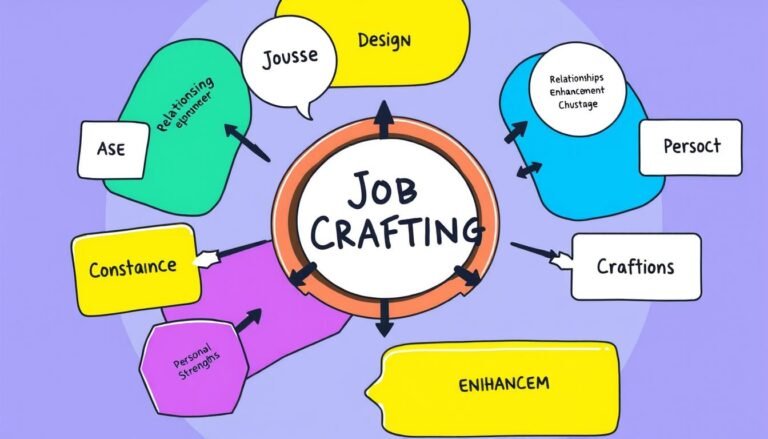Job Autonomy: Why It’s the Secret Weapon for Organizational Success
Ever wondered why some companies do well while others don’t? It’s not just about fancy perks or the latest tech. Something much simpler is key: job autonomy. This idea is changing how we work and making companies succeed in amazing ways.
Take eLearning Mind (ELM) for example. They let their team work in ways that feel right to them. This has led to happier, more confident, and creative employees. It’s no wonder ELM has grown a lot, with over 30 people in New York and San Diego.
But ELM isn’t the only one using autonomy to boost productivity. SOUTHWORKS has also seen big changes. They’ve doubled in size while making their structure half as complex. By letting project teams make their own decisions, they’ve built a culture of trust and success.
These stories show a bigger trend. Job autonomy is becoming a key factor in making employees and companies thrive. We’ll look into how you can use this secret weapon in your workplace too.
Key Takeaways
- Job autonomy boosts employee satisfaction and innovation
- Companies like ELM and SOUTHWORKS have seen significant growth with autonomous practices
- Autonomous work environments foster trust and high performance
- Empowering employees in decision-making leads to increased productivity
- Real-time data sharing promotes transparency and accountability
- Flexible work arrangements are a key aspect of job autonomy
Understanding Job Autonomy in the Modern Workplace
The modern workplace is changing, with job autonomy at the forefront. This change shows how important it is for employee happiness and keeping workers.
Definition and Importance of Job Autonomy
Job autonomy means employees have the freedom to make their own work decisions. It’s now a key part of the workplace. A study by Jabra found that over 5,000 employees worldwide value flexibility more than salary or benefits.
Evolution of Workplace Autonomy
Work discretion has moved from strict rules to more flexible models. Companies are starting to offer four-day workweeks and remote work. Lyra’s 2023 Workforce Mental Health Trends Forecast showed that 45% of benefits leaders now offer four-day workweeks.
Impact on Employee Satisfaction and Retention
Job autonomy greatly affects how happy employees are and how likely they are to stay. When employees have a say in their work, they feel more valued. This leads to higher job satisfaction and better well-being, making them more likely to stay.
| Aspect | Impact of Job Autonomy |
|---|---|
| Creativity | 35% of workers report limited time for creativity (Gallup study) |
| Job Satisfaction | Higher levels reported by autonomous workers |
| Retention | Improved employee retention rates |
| Productivity | Increased engagement and output |
By embracing job autonomy, companies can create a better work environment. This environment fosters happiness, boosts retention, and leads to success in today’s workplace.
The Psychological Benefits of Autonomous Work Environments
Autonomous work environments offer big psychological benefits to employees. These roles let people feel like they own their work. This makes them happier and more motivated at work.
Research shows that having control at work is key for happiness. The U.S. Surgeon General says it’s vital for mental health at work. It lets people decide when, where, and how to do their work.
People with more control at work are more engaged and motivated. They feel trusted to make choices, which boosts their confidence. This trust also encourages creativity and new ideas at work.
“Autonomy fosters a culture of trust and mutual respect within organizations.”
When employees can manage their tasks, they’re happier. They learn to lead and take pride in their work. This leads to better retention and more productivity.
| Benefits of Job Autonomy | Impact on Employees |
|---|---|
| Increased productivity | Higher job satisfaction |
| Enhanced creativity | Improved well-being |
| Better skill development | Stronger work engagement |
| Reduced turnover | Greater sense of ownership |
On the other hand, not having control can make people less productive and more likely to leave. Being too closely watched can make staff unhappy and unmotivated.
By supporting autonomy, companies create a better work place. This approach fits with today’s ideas on how to motivate workers. It shows that letting people take charge is key to success.
Job Autonomy: The Key Driver of Employee Motivation
Job autonomy is key to boosting employee motivation and productivity. Recent studies show how workplace autonomy affects employee performance and satisfaction.
Intrinsic Motivation and Autonomy
Intrinsic motivation comes from doing a task for its own sake. When employees control their work, they feel a sense of ownership. A survey showed 79% of employees left due to lack of appreciation, showing autonomy’s importance.
Fostering Creativity and Innovation
Autonomy lets creativity and innovation thrive. Giving employees freedom to decide encourages new ideas. This boosts productivity by 5.2% on average, showing autonomy’s power.
Self-Determination in Workplace Performance
Self-determination is crucial for workplace success. Empowering employees through autonomy gives a competitive edge. Self-scheduling and cross-training improve work-life balance and versatility.
| Autonomy Factor | Impact on Performance |
|---|---|
| Flexible Work Arrangements | Increased job satisfaction and productivity |
| Decision-Making Authority | Improved problem-solving skills and initiative |
| Self-Scheduling | Better work-life balance and reduced burnout |
| Cross-Training | Enhanced versatility and autonomy |
Embracing job autonomy creates a culture that benefits everyone. It leads to more motivation, creativity, and performance.
Implementing Job Autonomy: Strategies for Organizational Leaders
Leaders in organizations are key to promoting job autonomy. They can change the workplace culture and make employees happier. A study from the University of Birmingham shows that 90% of managers have some autonomy. But, only half of lower-level workers feel the same way.
To close this gap, leaders need to empower their teams. They should set values that support success and let teams decide. When workers have flexible schedules, they are 40% more productive and 64% more focused.
To introduce job autonomy, the culture must change. Leaders should focus on results, not how to achieve them. This encourages creativity and innovation. Building trust is vital for delegating tasks and helping employees succeed.
| Autonomy Strategy | Impact |
|---|---|
| Flexible work arrangements | 80% increased employee loyalty |
| Decision-making authority | Enhanced engagement and motivation |
| Trust-based leadership | Improved productivity and creativity |
Good communication is crucial in autonomous work settings. Leaders should offer support and guidance when needed. By using these strategies, organizations can empower and boost their workforce’s productivity.
The Link Between Job Autonomy and Productivity
Job autonomy is key to making workplaces more efficient. Research shows a clear link between giving workers freedom and better productivity. Let’s dive into how companies can make this work.
Case Studies of Successful Autonomous Work Models
Many companies have seen big improvements with autonomous work. For example, eLearning Mind found their workers were more productive and creative. SOUTHWORKS also grew a lot, doubling in size and making their structure simpler.
Measuring Productivity Gains in Autonomous Environments
Measuring success in free work environments is different. A study with 100 people showed some interesting things:
- Those who got 75% or more math problems right got $10 each
- People earned $16 to $30 based on their choices and team work
- CFOs like to measure output and revenue per employee
Overcoming Implementation Challenges
Starting autonomous work can be tough. There are a few big challenges:
- It takes time for everyone to adjust
- Building trust and being open is crucial
- Finding the right balance between freedom and responsibility
- Changing from controlling to empowering
To beat these challenges, companies should build trust, use performance metrics, and offer digital coaching. This helps identify strengths and weaknesses. By tackling these issues, businesses can fully enjoy the benefits of job autonomy.
Flexible Work Arrangements: A Manifestation of Job Autonomy
Flexible work arrangements are changing the game in today’s workplaces. Companies now see the value in offering telecommuting and remote work options. These moves show how job autonomy is in action.
A study by Queen’s Centre for Business Venturing found interesting results. Firms with happy employees saw 26% less turnover, 20% less absenteeism, and 15% more productivity. This shows how flexible work boosts success.
In the UK, people spend only 1.6 days a week in the office. Starting April 2024, UK workers will legally ask for flexible work from their first day. This change comes from the Employment Relations Act 2023.
- Improved work-life balance
- Increased job satisfaction
- Lower burnout risks
- Better employee retention
Technology is key in making flexible work possible. Tools like Slack, Microsoft Teams, and Zoom make communication easy. AI and machine learning help with routine tasks, letting employees do creative work.
“Flexible working schedules and radical flexibility are recommended to increase happiness and engagement among staff, fostering levels of productivity that outperform legacy companies.”
As companies adopt flexible work, they must keep communication open. Regular check-ins help employees adjust to new ways of working. This approach empowers workers and meets the demand for work-life balance in today’s job market.
Empowering Employees Through Decision-Making Authority
Giving employees the power to make decisions changes everything. It builds a culture of trust and innovation. This leads to more engagement and productivity. Research shows that giving employees freedom boosts their motivation and performance.
The Power of Trust Delegation
Trust delegation is key to empowering employees. When leaders trust their team, it spreads confidence and responsibility. Google’s 20% time policy, for example, led to big hits like Gmail and Google News.
Effective Management Training
Training managers is crucial for empowering employees. Leaders need to move from controlling to coaching. This means:
- Setting clear expectations
- Providing ongoing support
- Recognizing achievements
- Modeling desired behaviors
Balancing Autonomy and Accountability
Empowering employees is important, but so is accountability. Toyota shows how to balance these. Workers can stop production if they find defects, improving quality and efficiency.
“Empowerment without accountability is chaos; accountability without empowerment is micromanagement.”
Organizations can empower employees by setting clear rules, starting with small tasks, and checking progress. This way, trust, innovation, and accountability can all grow together.
Job Crafting: Personalized Approach to Work Autonomy
Job crafting lets employees shape their jobs to fit their strengths and interests. This method has become popular, with a study getting 42,000 views and 78 citations. The study looked at how job crafting affects work and employee happiness.
Job crafting includes three main parts: task, relational, and cognitive crafting. Companies like Google and Zappos have used job crafting to great success. Google’s “20% time” policy led to big innovations. Zappos’ focus on employee empowerment made their company culture amazing.
The study found that job crafting boosts happiness at work. This supports Self-Determination Theory, which says autonomy, relatedness, and competence are key. By letting employees customize their jobs, companies can create a more engaged team. This also opens up new career paths as people take charge of their work.
Job crafting has many benefits, like less stress and more engagement. But, it needs careful management. Leaders must make sure creativity doesn’t harm the company’s goals. When done right, job crafting can change the workplace for the better, making it more adaptable and happy.
Source Links
- Hands-Off Leadership: Using Autonomy as a Secret Weapon for Productivity
- How cultivating autonomy and trust helps us succeed
- Autonomy in the Workplace: Why Its So Important
- Foster Autonomy in the Workplace to Enhance Team Performance
- Job Autonomy and Work Meaning: Drivers of Employee Job-Crafting Behaviors in the VUCA Times
- What Does Autonomy at Work Really Look Like? – Axero Solutions
- The effects of psychological capital, work engagement and job autonomy on job performance in platform flexible employees – Scientific Reports
- Should I Stay or Should I Go (to the Office)?—Effects of Working from Home, Autonomy, and Core Self–Evaluations on Leader Health and Work–Life Balance
- Forget Flexibility. Your Employees Want Autonomy.
- The Unexpected Benefits of Employee Autonomy | Celayix
- How to Design a Job That Motivates Employees
- How to Encourage Autonomy in the Workplace: 5 Effective Strategies | Elevate Leadership
- Autonomy at Work Is Important. Here’s Why and 9 Tips to Encourage it
- Frontiers | Autonomy Raises Productivity: An Experiment Measuring Neurophysiology
- Autonomy in the Workplace: Boost Employee Productivity and Happiness
- The Power of Choice: How Autonomy Can Drive Employee Engagement and Productivity – CoachHub
- Autonomy at Work: Why Freedom is More Valuable Than Flexibility | Runn
- The flexible work revolution: embracing trust, autonomy, and technology – HRD
- The “Too-Much-of-a-Good-Thing” Effect of Job Autonomy and Its Explanation Mechanism
- Empowerment And Autonomy | Enhancing Employee Engagement
- Empowering employees and decision-making
- Day 124: Empowering Employees Through Meaningful Work and Autonomy
- Workplace Well-Being: The Role of Job Crafting and Autonomy Support – Psychology of Well-Being
- The Unexpected Upsides of Letting Employees Define Their Jobs | Benjamin Laker and Stefania Mariano
- Job crafting mediates the relation between creativity, personality, job autonomy and well‐being in Lebanese nurses







